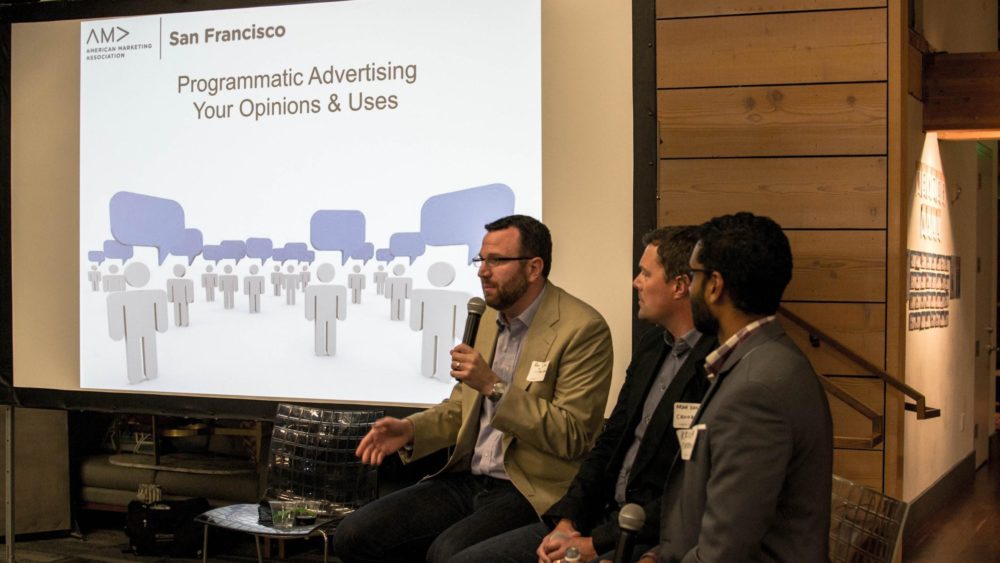Last Tuesday October 17th, the AMA SF hosted “The Rise of Programmatic” on at Galvanize in SOMA to discuss a hot topic in marketing: programmatic ad buying. Brian Cooper, Director of the Marketing Analytics and Data Sciences team at Juniper Networks, moderated the discussion.
On the panel was Aran Dahl, Senior Sales Director for Choozle, Krish Sailam, VP of Programmatic Strategy at Cadreon, and Ari Stein, Director of Programmatic Sales at Pandora.
What is programmatic advertising?
Programmatic ad buying is “using software to purchase digital advertising, as opposed to RFPs, human negotiations and manual insertion orders” (Digiday). Krish explained, “Ten to fifteen years ago, people were calling Yahoo! to pay for a certain spot on their home page. And what you paid for was everyone that visited their website. But [with programmatic], you can choose the specific audience that sees your ad.” Essentially, the argument goes, programmatic ad buying better allocates marketing budget dollars, accesses more ad inventory, and provides better targeting.

Data, data, data
At the core, data is what drives programmatic. For the panel discussion, Ari Stein explained the role of data in programmatic at Pandora, a music publisher based in Oakland, Ca. Pandora is on the supply side of the programmatic process, where they gather technographic data, census data, music habits, etc. to provide ad buyers with information that helps them place ads more effectively. As Ari explained, “Pandora is an audience platform,” and by using audience data, programmatic ad buyers are able to efficiently determine the worth of each customer and adjust their bidding plan accordingly. Also within programmatic, Pandora’s ad buyers are able to use a larger set of specifications in determining audiences for their ads because they are able to attribute multiple data points to their target audience. Brian explained, “Before, you had to choose two of the three: time, cost, quality. Now, marketers can have all three.”
The dark side of programmatic
But with all the excitement and promises of programmatic’s efficiency, there are still some skeptics, and the process is far from perfect. One common fear amongst advertisers is that there is not enough transparency with programmatic which can lead to problems of not knowing exactly where the ads are displayed and concerns about brand alignment (where is my ad appearing? What type of content is my ad appearing next to?).
One attendee asked the panelists: “What are your worst nightmares with programmatic?” Krish and Ari both mentioned the safety of the brand and how being clumsy with the campaigns can potentially lead to ads being placed next to hurtful content. Krish advises to “never let your guard down because technology will always be slightly behind.” Although the process is no longer manual, it does not replace the need for marketers to manage and optimize campaigns while preventing these brand-safety issues as much as possible.

Programmatic’s Next Frontier: Television
Later in the discussion the panelists addressed the future of programmatic in television. Historically, TV has targeted audiences based on demographic factors such as age, show ratings, gender, or location, whereas other media types (like print) have more specific audience segmentation (like interests). However, this trend is beginning to change as major networks shift towards programmatic.
When asked about how programmatic will be different in 1-2 years, Krish told the audience, “Some of the major networks are working on getting better data on who their audience is and making the info available for programmatic”. Once TV networks are able to provide a clearer picture of the audience with more data, advertisers on TV will no longer have to forecast who will be watching a specific segment or have “wasted” inventory.
Looking to the future
As programmatic grows and becomes a major player in every brands’ marketing mix, it is exciting to consider what will become of the platform. For example, how will machine learning and artificial intelligence (AI) impact programmatic advertising?
We’ll tackle that and much more at our next AMA SF event on November 16: “Harnessing the Power of AI”, attend our next AMA event: http://bit.ly/2yGDvJ3
Career Tip:
If you are looking to start a career in programmatic ad-buying, be ready to utilize both your right and left brain. As one of the panelists suggests, “The ideal traits [for a career in programmatic] would be a double major in Math and English.” The background in math is to understand the modelling and the algorithms, while the English is to have the ability tell the story of the data.
Author: Rebecca Tsui www.linkedin.com/in/rebeccatsui




Comments are closed.